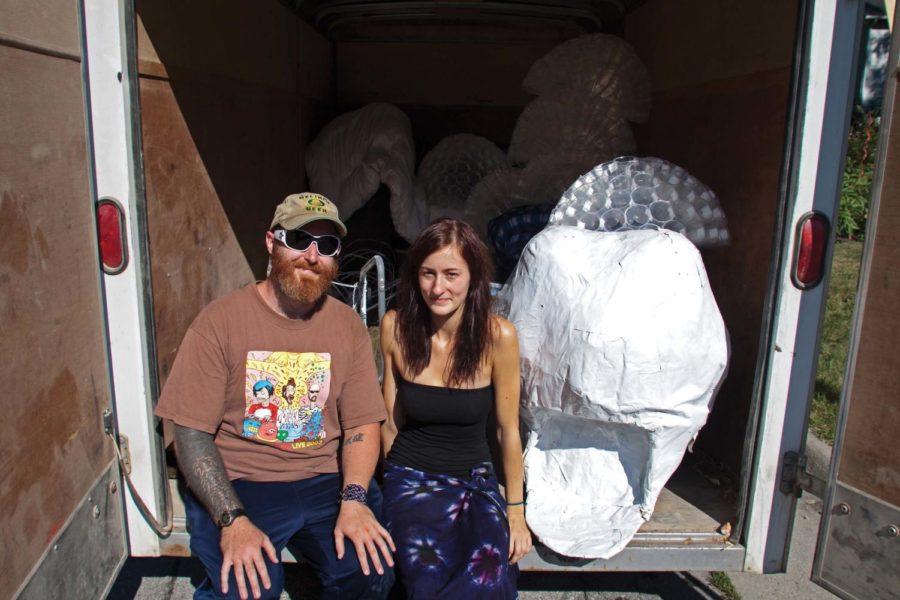Burning Man Project builds idyllic city
Photo: Cristobal Matibag/Iowa State Daily
Lyndsey Batz, junior in political science, and Jay Parry, senior in English, pack a trailer in preparation to leave for their trip to Burning Man 2011 on Friday at Parry’s home. Burning Man is a weeklong annual art festival that takes place in Nevada’s Black Rock Desert.
March 8, 2012
In the deserts of Nevada, there is a mirage-like city that appears and disappears annually, leaving no trace that it ever existed when it goes. The Burning Man Project, started in 1986 and named for the annual bonfire of the Burning Man — an effigy — is a pilgrimage and rite of passage for artists who spend a week living in Black Rock City, a temporary city of art that inhabits 55,000 people.
There are rules for to those wish to live in Black Rock City, and someone who knows them quite well is Samantha Krukowski, adjunct assistant professor of architecture.
For two years Krukowski has taught students in her summer class, “Burning Man Studio,” about the culture and ideology of the Burning Man Project.
Krukowski is the only professor in the world who does this, making the College of Design’s Burning Man Studio one of a kind. In addition to learning about the project, students are given the opportunity to create art to be integrated into Black Rock City.
However, the Burning Man Project is not the average art show.
Instead of professional artists creating masterpieces to be hung on plain white walls, the art in Black Rock City is meant to be touched, felt and interacted with. The founding theme of the Burning Man Project is “Radical Self-Expression,” or to express oneself with art openly and to interact with art freely and unrestrained.
One more thing — when artists leave, they have two choices: take their art with them or burn it.
Black Rock City is a unique place for the spread of art and ideas, sacred to its inhabitants and those who believe in the Burning Man Project. Inhabitants of Black Rock City spend a week in the desert, living off only what they need to survive and by a set of standards and ethics, called the 10 Principles, set down by the Burning Man Project.
Tickets to the project sold out for the first time in 2011, as the Burning Man Project has boomed in popularity and prestige steadily since 1986. However, in 2012 the project sold out with a little under a third of people who wanted to attend the Burning Man Project being unable to buy tickets — but not for the reason most would think.
Krukowski says 25,000 people who wanted tickets were unable to purchase them, and tickets are surfacing on eBay for far more their original price.
According to the New York Times, tickets were originally priced $360 to $420 but are on sale for as much as $5,000. About 40 percent of the people who did manage to purchase tickets have never stepped foot in Black Rock City, with a large number of Burning Man veterans being unable to purchase tickets.
Jason Parry, senior in English and a participant of the 2011 Burning Man Project, called the scalping, or buying to sell at a higher price, of tickets to the project as unethical.
“The idea of Burning Man at heart is a gifting community,” Parry said.
Besides coffee and ice, all things in Black Rock City are free — another one of the 10 Principles called “Gifting.”
Despite the ticket controversy, Krukowski will still be holding her summer studio that prepares students for the Burning Man Project.
Krukowski says she managed to get a hold of 12 tickets, though not without difficulty or the generosity of friends.
Keeping with the principle of “Radical Inclusion” all students at Iowa State are welcome to take “Burning Man Studio,” regardless of major, skill level or experience.
The 12 spots will be open for the 2012 summer session, and Krukowski welcomes anyone who is interested to try and snag a spot.
“12 students at Iowa State have tickets that 25,000 people want,” Krukowski said. “I feel like Willy Wonka.”







